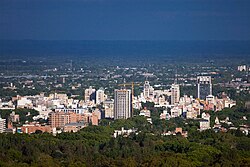
Back مندوزا (الأرجنتين) Arabic ميندوزا ARZ Mendoza (Arxentina) AST Mendoza (Arxintina) Aymara مندوزا (آرژانتین) AZB Мендоса Byelorussian Мэндоса (горад) BE-X-OLD Мендоса Bulgarian Mendoza (kêr) Breton Mendoza Catalan
Mendoza
Huentota | |
|---|---|
| City of Mendoza Ciudad de Mendoza (Spanish) | |
 Mendoza skyline | |
Location in Argentina | |
| Coordinates: 32°53′23″S 68°50′40″W / 32.88972°S 68.84444°W | |
| Country | |
| Province | |
| Department | Capital |
| Settled | 1561 |
| Founded by | Pedro del Castillo |
| Named for | García Hurtado de Mendoza, 5th Marquis of Cañete |
| Government | |
| • Mayor | Alfredo Cornejo (UCR) |
| Area | |
| • City | 54 km2 (21 sq mi) |
| Elevation | 746.5 m (2,449.1 ft) |
| Population (2010 census) | |
| • Density | 2,055.4/km2 (5,323/sq mi) |
| • Urban | 115,041 |
| • Metro | 1,033,000 (2,021 est.)[1] |
| • Demonym | Mendozan (Mendocino/-a Spanish) |
| GDP (PPP, constant 2015 values) | |
| • Year | 2023 |
| • Total | $28.7 billion[2] |
| • Per capita | $23,400 |
| Time zone | UTC−3 (ART) |
| CPA Base | M 5500 |
| Area code | +54 261 |
| Climate | BWk |
| Website | ciudaddemendoza.gov.ar |
Mendoza (Latin American Spanish: [menˈdosa]), officially the City of Mendoza (Spanish: Ciudad de Mendoza), is the capital of the province of Mendoza in Argentina. It is located in the northern-central part of the province, in a region of foothills and high plains, on the eastern side of the Andes. As of the 2010 census [INDEC], Mendoza had a population of 115,041 with a metropolitan population of 1,055,679, making Greater Mendoza the fourth largest census metropolitan area in the country.
Ruta Nacional 7, the major road running between Buenos Aires and Santiago, runs through Mendoza. The city is a frequent stopover for climbers on their way to Aconcagua (the highest mountain in the Western and Southern Hemispheres) and for adventure travelers interested in mountaineering, hiking, horse riding, rafting, and other sports. In the winter, skiers come to the city for easy access to the Andes.
Two of the main industries of the Mendoza area are olive oil production and Argentine wine. The region around Greater Mendoza is the largest wine-producing area in South America. As such, Mendoza is one of the eleven Great Wine Capitals,[3] and the city is an emerging enotourism destination and base for exploring the region's hundreds of wineries located along the Argentina Wine Route.
- ^ "Mercado de trabajo. Tasas e indicadores socioeconómicos (EPH)" (PDF). Indec. March 2022. p. 17. Archived (PDF) from the original on 24 May 2022. Retrieved 22 May 2022.
- ^ "TelluBase—Argentina Fact Sheet (Tellusant Public Service Series)" (PDF). Tellusant. Archived (PDF) from the original on 16 January 2024. Retrieved 11 January 2024.
- ^ "The Great Wine Capitals". Archived from the original on 7 August 2019. Retrieved 30 September 2019.
© MMXXIII Rich X Search. We shall prevail. All rights reserved. Rich X Search


